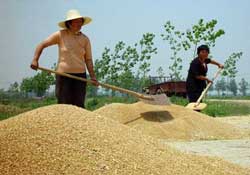Preserving household-sized paddy
During storage, paddy seeds often suffer from a number of phenomena: mold, fermentation, moth infection, moisture transfer in grain mass, self-heating . when suffering from the above phenomena, the quality of paddy is reduced, the content of nutrients and commercial value decreased.
To overcome and help reduce losses during harvesting, storage and circulation, farmers need to apply the following basic techniques.
Harvest

(Photo: VNN)
Newly harvested rice is often high in moisture, so some varieties can germinate, moldy yeast and fungi are easy to grow, causing rice to be damaged or poor in quality. Normally the moisture content of paddy is only 20-27% when harvested. To prevent rice from being damaged or reduced in quality, within 48 hours after harvest, dry the rice so that the moisture content is only 20%, then continue processing. Depending on the need to dry rice for milling immediately or for long-term storage or to make varieties that require drying and different drying technologies. The drying process must allow the moisture to escape slowly to achieve the desired moisture content, while ensuring the smallest difference in the temperature of the grain compared to the outside.
The safe moisture content of paddy for storage depends on the grain, climate and storage conditions. When paddy with 13-14% moisture content can be stored for 2-3 months, if you want to preserve longer than 3 months, the moisture content of the best paddy is 12-12.5%. The moisture content of paddy, drying technology also affects the rice recovery efficiency and the rate of broken rice during milling process, the appropriate moisture content for milling is from 13-14%.
Clean
After beating, threshing, it is necessary to remove inorganic impurities (sand, gravel, stone, metal .) as well as organic impurities (fresh leaves, dry leaves, straw, sometimes animal manure). .) mixed in when plucking.
Classify
Removing green, flat, broken, peeled particles during transport, beating, plucking, making axles . as well as pest seeds. Can be sifted or sifted by wind (electric fan, wind .). Only good grain quality and quality assurance should be preserved.
Dry
- Exposure method:
Rice is dried in the sun, air temperature is up to 40 degrees Celsius, the temperature on the cement yard, the tile yard can reach 60-70 degrees Celsius, then the grain temperature can exceed 50 degrees C and the water inside the rice grain does not have enough time to diffuse to the outside, causing the grain to crack, when milling the high broken rice. Exposed in this way, it is only necessary to dry rice continuously from 8-9 am to 4-5 pm in 2-3 sunny days, which is rice can be milled. Rice is dried into beds, each bed is about 10-15cm high, 40-50cm wide and half an hour scratched once in different directions.
- Long drying method:
This method requires more time and labor but less rice is broken. The rice is spread into beds like the above but the first day only exposes the rice in the sun for 2 hours, the second day for 3 hours, the third day for 4 hours. Every 15 minutes, the beds are stirred once in different directions. In the first 3 days, after drying in the sun, the rice should be kept in a shady place, the more airy the better. The following days, the rice continued to be dried for 5-6 hours / day until the rice had moisture suitable for milling or storage. If the sun is good, then on the 4th day, the moisture content of the rice reaches the standard for milling and preservation.
In addition, rice is dried by artificial methods such as: drying rice with hot air, convection drying, radiation drying . These methods have the advantage that rice can be dried at any time and regardless of sunny or rainy weather, the moisture content of the grain can be rationally controlled during the limited time and when milling, the rice recovery efficiency is higher than that of natural drying.
Preservation:
Rice husks have the effect of limiting the external impacts such as temperature, humidity and partly preventing the infection of insects, yeast, mold . this is an advantage of rice in storage. However, the process of preserving rice is also greatly influenced by external conditions. After being dried, the fans are clean, the paddy is processed, used immediately or put into storage. During storage, it is necessary to ensure that the paddy does not get wet, not moldy and does not occur hot, no insects, mice attack.
Paddy after being dried to a safe moisture, remove impurities and need to be appropriately preserved in tools such as jars, pots, pots, bags, barrels, phi, granary, ark, wooden crate, box . for storage in warehouses with large and small spaces depending on the amount of paddy to be preserved and built according to the technical requirements of the treasure for rice preservation.
- 12 widgets you are still using but have no idea they have expired
- Household items with limited shelf life
- 10 extreme household cleaning tips or vinegar
- In the past, there was no refrigerator, what was the food preservation?
- Shelf life of meat types
- Improved silo: New technology for preserving agricultural products
- Video: Family objects change through history
- Fruits and vegetables cannot be stored together
- Unique pen capable of scanning documents and recording
- Harvesting and preserving strawberries
- Preserving vegetables for weeks with thin film
- Found earthworms that contain chemicals from household and animal manure
 'Barefoot engineer' invents a pipeless pump
'Barefoot engineer' invents a pipeless pump Process of handling dead pigs due to disease
Process of handling dead pigs due to disease Radiometer
Radiometer Warp Engine: Technology brings us closer to the speed of light
Warp Engine: Technology brings us closer to the speed of light